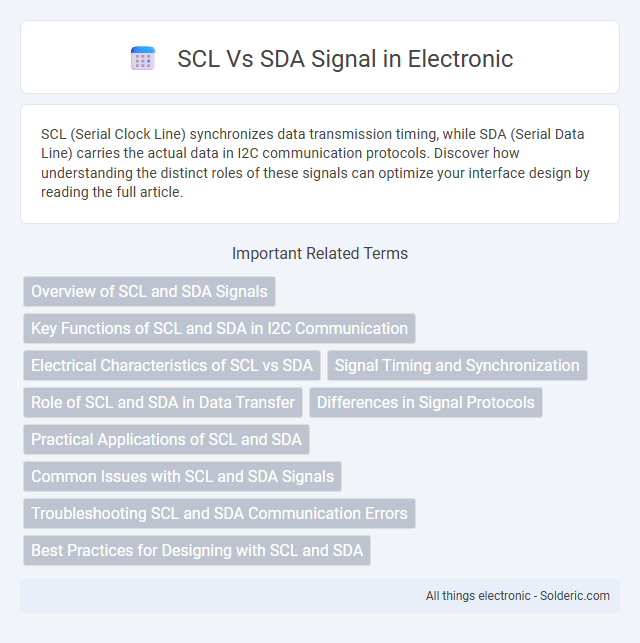SCL (Serial Clock Line) synchronizes data transmission timing, while SDA (Serial Data Line) carries the actual data in I2C communication protocols. Discover how understanding the distinct roles of these signals can optimize your interface design by reading the full article.
Comparison Table
| Aspect | SCL (Serial Clock Line) | SDA (Serial Data Line) |
|---|---|---|
| Function | Provides clock pulses to synchronize data transfer | Carries serial data between devices |
| Signal Type | Clock signal | Data signal |
| Direction | Master controlled, unidirectional (clock output) | Bidirectional data line |
| Voltage Level | Typically open-drain, pulled up by resistor | Typically open-drain, pulled up by resistor |
| Role in I2C Protocol | Controls timing of data transmission | Transfers address and data bits |
| Data Rate Association | Determines speed: standard (100 kHz), fast (400 kHz), etc. | Data transmitted at SCL clock rate |
Overview of SCL and SDA Signals
SCL (Serial Clock Line) and SDA (Serial Data Line) are the two essential signals in the I2C communication protocol, enabling synchronous data transfer between master and slave devices. SCL carries the clock pulses generated by the master to synchronize data transmission, while SDA transmits the actual data bits bidirectionally between devices. Both lines are open-drain and require external pull-up resistors to maintain communication integrity and ensure proper signal levels.
Key Functions of SCL and SDA in I2C Communication
The SCL (Serial Clock Line) generates synchronized clock pulses essential for timing control in I2C communication, ensuring data bits are sent and received at precise intervals. The SDA (Serial Data Line) carries the actual data bits and acknowledgment signals between master and slave devices, facilitating bidirectional data transfer. Together, SCL and SDA enable synchronous serial communication by coordinating data flow and timing on the I2C bus.
Electrical Characteristics of SCL vs SDA
The SCL (Serial Clock Line) and SDA (Serial Data Line) signals in I2C communication exhibit distinct electrical characteristics crucial for proper bus operation. SCL operates as a clock signal that synchronizes data transfer, typically characterized by a defined frequency, rise/fall times, and controlled load capacitance to maintain signal integrity. SDA serves as a bidirectional data line with open-drain/open-collector architecture, requiring pull-up resistors to Vcc, which affects its voltage levels, rise times, and susceptibility to bus capacitance and noise, making its electrical behavior more sensitive than the SCL line.
Signal Timing and Synchronization
SCL (Serial Clock Line) controls the timing and synchronization of data transfer on the SDA (Serial Data Line) in I2C communication by generating clock pulses that dictate when data bits are sampled and transmitted. Precise timing on the SCL signal ensures data integrity on the SDA line, with each data bit on SDA required to be stable during the high period of the SCL clock. Understanding the synchronization between SCL and SDA signals is crucial for optimizing communication speed and preventing data corruption in your embedded systems.
Role of SCL and SDA in Data Transfer
SCL (Serial Clock Line) controls the timing of data transfer by providing clock pulses that synchronize the communication between devices on the I2C bus. SDA (Serial Data Line) carries the actual data bits transmitted or received, changing state only when SCL is low to ensure stable data during clock pulses. Together, SCL and SDA enable precise and reliable half-duplex data exchange between master and slave devices in I2C communication.
Differences in Signal Protocols
SCL (Serial Clock Line) controls timing by generating clock pulses to synchronize data transmission, while SDA (Serial Data Line) carries the actual data bits in the I2C protocol. The SCL signal is a unidirectional line driven by the master device to regulate communication speed, whereas the SDA signal is bidirectional, allowing both master and slave devices to send and receive data. These differences in signal protocols ensure efficient synchronization and data transfer in inter-integrated circuit communication systems.
Practical Applications of SCL and SDA
SCL (Serial Clock Line) and SDA (Serial Data Line) are essential components of I2C communication used in microcontrollers and embedded systems for sensor data acquisition and device control. Your devices rely on the SCL signal to synchronize data transfer timing, while the SDA line carries the actual data bits between master and slave devices. Practical applications include temperature sensors, EEPROM memories, and real-time clocks where precise data exchange is critical for system reliability.
Common Issues with SCL and SDA Signals
Common issues with SCL and SDA signals in I2C communication include signal degradation due to long bus lengths causing increased capacitance, leading to slower rise times and potential data errors. Noise interference and improper pull-up resistor values can result in signal distortion or incomplete voltage level transitions, disrupting clock synchronization and data integrity. Crosstalk between adjacent signal lines and poor PCB layout also contribute to signal reliability problems, necessitating careful design and troubleshooting.
Troubleshooting SCL and SDA Communication Errors
Troubleshooting SCL and SDA communication errors often involves checking for loose connections, proper pull-up resistor values, and signal integrity issues such as noise or timing mismatches on the I2C bus. Using an oscilloscope or logic analyzer can help identify stuck lines, voltage drops, or incorrect clock pulses affecting the SCL (Serial Clock) and SDA (Serial Data) signals. Verifying correct device addressing and ensuring that all devices comply with the I2C protocol timing specifications are crucial steps to resolve communication errors.
Best Practices for Designing with SCL and SDA
For robust I2C communication, ensure proper pull-up resistors are chosen for SCL and SDA lines to maintain signal integrity and timing accuracy. Minimize bus capacitance by keeping trace lengths short and using proper PCB layout techniques to reduce noise and signal degradation. Your design should also incorporate appropriate filtering and shielding to prevent interference and optimize reliable data transfer on the SCL and SDA signals.
SCL vs SDA signal Infographic

 solderic.com
solderic.com